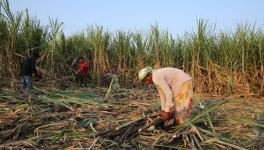ASHA and Anganwadi Workers Are the Backbones of India’s Rural Health and Care Services
The contribution of passionate women who work as Anganwadi and ASHA workers must be recognised by the formal governance systems. MOIN QAZI writes about his experience and interaction with Anganwadi workers and what India must do to enhance the systems. They deserve a better deal as they are committed and dedicated despite being grossly underpaid.
During my professional engagements with rural India, I found that one of the most useful resources at the grassroots level was an Anganwadi worker. I would always begin my village exploration with a visit to an Anganwadi (government-run daycare centres) and would be rewarded with a nuanced introduction to the local community. I have always regarded Anganwadi workers as the most efficient and trustworthy last-mile connections. Their delivery on the ground is both committed and empathetic.
In normal times, India’s army of Anganwadi workers is on the frontline of the country’s war against undernutrition.

Today, it has joined another battle — the battle against COVID-19. With the outbreak of the pandemic, the nation’s 2.7 million Anganwadi workers became frontline responders in their communities. On top of their usual responsibilities, they distribute dry rations and cooked food, screen people for COVID-19, and spread awareness of the virus.
Since they know their people well and have intimate on-the-ground experience, this legion of Anganwadi workers is extensively employed by district administrations. Dealing with emergencies is, therefore, not alien to their cadre.
This voluntary workforce of poorly paid, semi-literate women is India’s first line of defense against any local health crisis.
Since they know their people well and have intimate on-the-ground experience, this legion of Anganwadi workers is extensively employed by district administrations. Dealing with emergencies is, therefore, not alien to their cadre.
Anganwadi workers are a resilient workforce and can adapt very quickly to difficult circumstances.
Anganwadi workers are paid around Rs 5000 a month ($68), less than half of India’s average monthly salary of $148.
An Anganwadi worker is usually a local village woman, between 18 to 35 years of age and educated up to class X.
Also read: Accredited Social Health Activists struggle for survival
Anganwadi workers are paid around Rs 5000 a month ($68), less than half of India’s average monthly salary of $148. Workers provide supplementary nutrition for children, pregnant women, and nursing mothers, teach mothers about child nutrition, and give pre-formal school education
Meerabai- A dedicated Anganwadi Worker
An Anganwadi worker whom I have known for most of my professional life and who is still active in that role is Meera Chaudhary of Wanoja village in Maharashtra. I remember fondly my first encounter with Meerabai. She lived in a primitive house which had a very low entrance. I had to bend down to get in. Meerabai had a goat which she milked to prepare tea for us. We became regular visitors and she always welcomed us with great warmth. We would spend time discussing local affairs and even politics although she had little interest in it.
When Meerabai became an Anganwadi worker in 1986, she received a monthly compensation of Rs 125. For Meerabai, the job was purely a labour of love. Anganwadi work was considered more of a social contract than a source of stable income.
Since Meerabai was the primary interface of the village for outside development staff she was familiar with the niceties entailed in entertaining visiting dignitaries. I found her a wonderful host.
Her husband Vasantrao had a hair salon in the local town. When Meerabai became an Anganwadi worker in 1986, she received a monthly compensation of Rs 125. For Meerabai, the job was purely a labour of love. Anganwadi work was considered more of a social contract than a source of stable income.
Right from her enrolment as an Anganwadi worker, Meerabai worked passionately, treating all the children as her own family. This is the reason she was never allowed to retreat to the privacy of her home even when she was keen to take a holiday.
Meerabai’s organizing skills and her intimate bond with the community proved highly resourceful to us. She would host our meetings in her house and whenever the audience was larger, she would open the Anganwadi premises. While the Anganwadi activities were not part of our agenda, we got involved in it purely out of the intimacy we developed with Meerabai. We supported the Anganwadi with a small donation for procuring an audio player, a few tricycles and a collection of modern toys.
Right from her enrolment as an Anganwadi worker, Meerabai worked passionately, treating all the children as her own family. This is the reason she was never allowed to retreat to the privacy of her home even when she was keen to take a holiday.
She juggled the Anganwadi job even as she saw through the education and marriages of her three daughters. She saw several juniors join and leave the Anganwadi on account of lack of adequate incentives. But she couldn’t think of taking a reprieve because local parents could not imagine an Anganwadi without Meerabai.

Meerabai
Meerabai grew into a versatile resource primarily because she handled practically every grassroots role in the absence of a specifically-assigned government worker. There was a time when the block administration wanted to use Self Help Groups (SHGs) for promoting its nutrition mission for children and pregnant mothers. We already had groups for micro-finance. Meerabai provided us a platform for using them as conduits for social and financial programmes. Meerabai was uniquely positioned to provide financial and other advice to families
Also read: Social Security Code: Another Historic Opportunity Missed!
How is it that when every Anganwadi gets the same support from the government, some perform well while others lag behind? One major reason is leakage at every level where the aid is sponged off. As the aid travels, only a small part reaches the actual beneficiary.
A child’s early years have a disproportionate impact on the rest of their social, mental and emotional life up to adulthood. That’s why Anganwadis are considered a cost-effective way to raise a generation of healthy, socially-adept and productive adults.
Indians have learned to live with this so-called “chalta hai (it’s ok)” attitude. But you will get a better answer when you observe a typical day in Meerabai’s work schedule. She is meticulous about hygiene and the local inventory as also the quality of materials used for cooking mid-day meals for children. She pays attention to every minute detail so that the overall ambience of the Anganwadi remains stimulating.
Strengthening the Anganwadi model with resources
Anganwadi children belong to a very sensitive age band (under six years), when their vital cognitive and behavioural functions are being developed. Meerabai’s deep understanding of child development has made a huge difference.
A child’s early years have a disproportionate impact on the rest of their social, mental and emotional life up to adulthood. That’s why Anganwadis are considered a cost-effective way to raise a generation of healthy, socially-adept and productive adults.
It is far better than treating sick adults later.

Anganwadis are the primary units of the Integrated Child Development Services (ICDS), the world’s largest State-promoted social programme. ICDS was launched on October 2, 1975, with about 5,000 Anganwadis to deliver high-quality healthcare, nutrition, community education, pre-school non-formal education, immunisation, as well as referral services. The aim is to reduce infant mortality and child malnutrition.
According to government data, the country has 13.77 lakh Anganwadi. Anganwadis continue to be the backbone of India’s grassroots social services platform for women and children. Yet, child and maternal mortality remain high. The desired health outcomes are not achieved partly because the services that are promised are not delivered. The real value of the programme can be realised only when the cadre has devoted workers. They are the most authentic mascots of this mission which would complete a half-century in a few years.
These centres have undoubtedly expanded their reach, but they need to play a much larger role in anchoring community development.
Nearly a fourth of them lack drinking water facilities and 36 percent do not have toilets.
ICDS beneficiaries do register for them but because the Anganwadis lack adequate facilities, they turn to private options. These come at a price, hitting low-income families the hardest.
Anganwadi workers do not have any comprehensive manual on managing their roles. They are taught broad principles and it is left to their native wisdom to flesh out the details. An Anganwadi Worker (AWW) is entrusted with many tasks such as preparing voter identity cards, conducting a census, employment or Swachh Bharat Mission (Clean India Mission) surveys and helming election booths — none of which is paid work except for election duty.
ASHA workers play a key role in community health
Working alongside these Anganwadi workers are more than nine lakh Accredited Social Health Activists (ASHAs). The ASHA initiative was the result of the 2005 National Rural Health Mission, affiliated with the Ministry of Health and Family Welfare.
An ASHA is the first port of call for any health-related demands of the deprived sections of the rural population, especially women and children. ASHAs also perform several other duties that make their role peripatetic.
A single ASHA worker looks after more than one thousand families in an administrative unit.
ASHAs are drawn from local and largely rural communities, and are a crucial element in India’s primary and community health programmes. They go door-to-door educating people about maternal and child health, contraception, immunisation, and sanitation, as well as enrolling them in health programmes and monitoring the results. They also ensure immunization, give first aid, and administer antimalarial and anti-tubercular drugs and oral rehydration solutions (ORS).
An ASHA is the first port of call for any health-related demands of the deprived sections of the rural population, especially women and children. ASHAs also perform several other duties that make their role peripatetic.
But despite the key role they play in combating India’s health crises, Anganwadi workers and ASHAs do not have regular salaries, partly because their work is supposed to be voluntary and part-time. Most, however, end up working full-time due to local demands.
ASHAs earn based on incentives; they receive Rs 75 for each full immunization, Rs 40 for reporting child death, Rs 300 for accompanying a woman to a hospital for childbirth, and Rs 1000 for administering TB treatment over 6-7 months. They are being paid an additional Rs1,000 for COVID-19 interventions.
New Labour Codes fails ASHA and Anganwadi workers
But despite the key role they play in combating India’s health crises, Anganwadi workers and ASHAs do not have regular salaries, partly because their work is supposed to be voluntary and part-time. Most, however, end up working full-time due to local demands.
Also read: Fair wage is about rights of anganwadis, so why are ASHA workers denied minimum wages, benefits?
Even though the Code on Social Security, 2020 aims to include formal and informal sectors under a social safety net, it excludes several categories of workers, including ASHA and Anganwadi workers. The Code on Wages, too, has left this constituency out of its coverage, depriving employees of a fixed minimum wage.
A systematic lack of accountability remains a key barrier to programmatic effectiveness; only rarely is the staff held accountable for achieving targets. This lack of accountability manifests in a work culture that is not impact-oriented, marked by persistent tardiness and absenteeism, the achievement of only partial work responsibilities, and significant pilferage and leakage of the aid meant for beneficiaries.
The Code on Wages, too, has left this constituency out of its coverage, depriving employees of a fixed minimum wage.
Frontline Workers (FLWs) should be awarded for the achievement of targets through bonuses. This helps align incentives and does not inequitably penalise staff cadres who already receive limited compensation and have less control of challenges across the nutrition value chain.
Apart from bonuses, a mechanism could be devised to ensure that people who are responsible for delivering particular goods or services will not be paid unless they produce proper documentary evidence. Modern technologies could be applied to ensure accountability in services.
Each Anganwadi worker can be individually made responsible for services at her centre, thereby avoiding the problems associated with free-ridership.
Payment would be made based on overall outcomes among all the children at each centre, incentivising each worker the same way as payments to teachers for education outcomes are based on improved test scores.
The article was originally published in The Leaflet.
(Moin Qazi is a development professional. He has worked for over three decades with the State Bank of India as a grassroots field officer, program manager, policymaker, and researcher in development finance. The views are personal.)
Get the latest reports & analysis with people's perspective on Protests, movements & deep analytical videos, discussions of the current affairs in your Telegram app. Subscribe to NewsClick's Telegram channel & get Real-Time updates on stories, as they get published on our website.
























